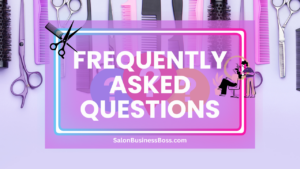Starting a hair product business can be a rewarding venture for entrepreneurs passionate about beauty and hair care. However, launching a successful hair product business requires careful planning, strategic decision-making, and an understanding of the market.
To start a hair product business, research and define your niche, select reliable suppliers or consider manufacturing in-house. Test products thoroughly, ensure top-notch quality, and invest in appealing branding. Focus on effective marketing, engage with customers, and prioritize exceptional customer support for success.
1. Decide Which Hair Products to Sell:
The success of your hair product business largely hinges on the careful selection of the products you wish to sell. To begin, conduct extensive market research to gain valuable insights into current trends and consumer preferences. Understanding the demands of your target audience is crucial in determining which products will resonate with them the most.
Consider narrowing your focus by choosing a niche segment, such as organic, all-natural, or vegan hair products. This specialization can set you apart from larger competitors and attract a dedicated customer base. Alternatively, offering a diverse range of products can cater to a broader audience, providing more opportunities for sales and growth.
When deciding on your product offerings, take into account various hair types, textures, and common hair care needs. Tailoring your products to specific customer segments can enhance customer satisfaction and loyalty. Invest time in gathering feedback and conducting surveys to gauge interest in potential product lines.
Remember that staying abreast of industry developments and keeping an eye on emerging trends can give your business a competitive edge. Ultimately, the key is to strike the right balance between your passion for hair care and the market demand for your selected products.
2. Research and Select a Supplier or Make It Yourself:
Once you have finalized your product lineup, the next critical step is determining how to procure them. You can either source from external suppliers or manufacture the products in-house. Each option has its advantages and considerations.
Conduct thorough research to identify potential suppliers. Evaluate their reputation, product quality, delivery efficiency, and pricing. Establishing strong relationships with reliable suppliers can ensure a steady supply chain and consistent product quality.
On the other hand, manufacturing in-house allows you to have full control over the production process, quality assurance, and customization. This approach is especially beneficial if you plan to offer unique formulations or cater to niche markets. However, manufacturing in-house requires substantial upfront investment, specialized equipment, and expertise.
Consider your budget, production capacity, and long-term business goals when making this decision. Some businesses may choose a hybrid approach, sourcing certain products externally while producing others in-house.
The success of your hair product business hinges on your ability to deliver high-quality products that meet or exceed customer expectations. Whether you choose to partner with suppliers or embark on in-house production, prioritize consistency and excellence to establish a solid foundation for your business.
3. Testing the Products After Receiving Them:
Thoroughly testing the hair products is an essential step before introducing them to the market. Whether sourced from suppliers or manufactured in-house, product testing ensures that the final offerings meet the promised quality and performance standards.
Testing should encompass a variety of aspects, including evaluating the products on different hair types and textures to ensure universality and suitability for diverse customers. Consulting with experts, such as professional hairstylists or dermatologists, can provide valuable insights into the products’ efficacy and safety.
During this testing phase, pay close attention to potential issues or improvements. Identify any adverse reactions or allergies and promptly address them to avoid any future complications. This process allows for necessary adjustments and refinements to optimize product performance and customer satisfaction.
Consumer feedback is invaluable during product testing. Consider conducting focus groups or sending samples to potential customers for their input. This feedback loop helps fine-tune formulations, packaging, and marketing strategies to align with customer preferences.
Remember, investing in product testing not only ensures the credibility and quality of your offerings but also demonstrates your commitment to providing effective and safe hair care solutions to your customers.
4. Quality Assurance and Compliance:

Maintaining a consistent and high level of quality is non-negotiable in the competitive hair product industry. Implementing a robust quality assurance (QA) process is vital to monitor every stage of production and distribution.
From sourcing raw materials to the final packaging, every aspect of the manufacturing process should be scrutinized to guarantee the desired product attributes. Regular inspections, internal audits, and compliance checks are instrumental in preventing quality deviations.
Adherence to industry standards and regulations is fundamental to ensure your products are safe and compliant. This includes compliance with labeling laws, ingredient restrictions, and packaging requirements. Stay informed about evolving regulations to remain ahead of any changes that might impact your business.
Comprehensive quality control measures should encompass ingredient sourcing, production protocols, product consistency, and storage conditions. Regularly assess and calibrate equipment to maintain accuracy and efficiency during manufacturing.
A well-established quality assurance process not only safeguards your brand reputation but also fosters trust and loyalty among your customers. Demonstrating your commitment to quality and compliance builds confidence and positions your hair product business as a reliable and trustworthy choice in the market.
Read more about: What Licenses Do You Need to Open a Salon: Ensuring a Legitimate Business
5. Packaging and Branding:
The packaging and branding of your hair products play a pivotal role in capturing the attention of consumers and establishing a strong brand identity. Invest in visually appealing and functional packaging that not only protects the products but also serves as an enticing marketing tool. Eye-catching packaging can create a lasting impression on customers and draw them towards your products, whether on store shelves or in the digital realm.
Create a compelling brand identity that resonates with your target audience. Consistency is key when building a brand, so carefully select brand colors, logo design, and a memorable tagline that reflects the essence of your business. These elements should be consistent across all your marketing materials and products to create a cohesive and recognizable brand image.
Effective branding evokes trust, reliability, and uniqueness in customers’ minds. It should communicate the values and personality of your hair product business, differentiating it from competitors. The packaging and branding should align with the products’ quality and the overall customer experience you aim to deliver.
6. Marketing and Promotion:
In the competitive hair product market, effective marketing and promotion are vital to create awareness and drive sales. Develop a comprehensive marketing strategy that aligns with your target audience and business objectives. Embrace digital marketing channels to reach a broader online audience, including social media platforms, search engine optimization (SEO), and email marketing.
Leverage social media to engage with potential customers and build a community around your brand. Create informative content, tutorials, and user-generated content that showcase your products’ benefits and demonstrate how to use them effectively. Encourage user participation and feedback to foster a sense of loyalty and trust.
Collaborating with influencers, beauty bloggers, and hair stylists can expand your brand’s reach and credibility. Influencers can promote your products to their followers, reaching potential customers who trust their recommendations. Participating in industry events, trade shows, and exhibitions can also provide valuable opportunities for networking and showcasing your products.
Remember, effective marketing is not just about selling but also about establishing an emotional connection with your target audience. By effectively communicating the unique selling points of your hair products and demonstrating how they can meet customer needs, you can position your brand as a leader in the competitive hair care market.
7. E-commerce and Distribution:
In today’s digital landscape, establishing a robust e-commerce presence is paramount for the success of your hair product business. Create an intuitive and user-friendly e-commerce platform that offers a seamless shopping experience for your customers. Ensure that the website is mobile-responsive, as an increasing number of consumers make purchases using their smartphones.
Consider partnering with established online marketplaces such as Amazon, Etsy, or other beauty-specific platforms. These platforms have a massive customer base, providing you with an opportunity to reach a broader audience and increase your brand visibility.
While e-commerce is essential, don’t overlook traditional distribution channels. Explore collaboration opportunities with local hair salons, beauty stores, and other retailers to expand your market reach and target customers who prefer in-store shopping experiences.
Implement an efficient logistics and shipping system to ensure timely delivery and customer satisfaction. Offer various shipping options and be transparent about shipping costs to avoid any surprises for your customers during the checkout process.
8. Customer Support and Feedback:

Providing excellent customer support is a cornerstone of building trust and loyalty with your customers. Offer multiple channels for customers to reach out, such as email, chat, or phone support, and respond promptly to inquiries. A responsive and helpful customer support team can leave a lasting positive impression on customers, encouraging them to return for repeat purchases.
Address any issues or concerns professionally and empathetically. Strive to resolve customer complaints promptly and go above and beyond to exceed their expectations. Remember that exceptional customer support can turn dissatisfied customers into brand advocates.
Encourage customers to leave feedback and reviews about their experience with your products and services. Customer feedback is invaluable for understanding their needs and preferences, helping you make informed decisions to improve your offerings. Utilize customer feedback as a tool for continuous improvement, and publicly respond to reviews to show that you value and appreciate your customers’ input.
By focusing on exceptional customer support and actively seeking feedback, you can build a loyal and engaged customer base that will contribute to the long-term success of your hair product business.
Read more about:
Conclusion
Starting a hair product business requires careful planning, dedication, and a commitment to delivering high-quality products and exceptional customer experiences. By deciding on the right hair products to sell, selecting reliable suppliers or manufacturing in-house, conducting thorough product testing, maintaining stringent quality control measures, and implementing effective marketing strategies, you can build a successful hair product brand that resonates with customers and stands the test of time. Remember, continuous improvement, innovation, and customer-centricity are key to thriving in the dynamic hair care industry.
Frequently Asked Questions

1. Is it essential to offer exceptional customer support?
Absolutely. Great customer support builds trust and loyalty. Provide multiple communication channels and address inquiries or issues promptly and professionally.
2. What are some cost-effective marketing strategies?
Utilize social media platforms, create engaging content, and run targeted online advertisements to reach potential customers without significant upfront costs.
3. How can I stay competitive in the hair product market?
Continuously innovate and stay up-to-date with industry trends. Offer unique features, eco-friendly options, or personalized products to stand out from competitors.
To learn more on how to start you own salon checkout my startup documents here.
Please note that the contents of this blog are for informational and entertainment purposes only and should not be construed as legal advice. Any action taken based on the information provided in this blog is solely at your own risk. Additionally, all images used in this blog are generated under the CC0 license of Creative Commons, which means they are free to use for any purpose without attribution.

About the author. Entrepreneur and Salon Business Fan.
Hi! I am Shawn and I am a happy individual who happens to be an entrepreneur. I have owned several types of businesses in my life from a coffee shop to an import and export business to an online review business plus a few more and now I create online salon business resources for those interested in starting new ventures. It’s demanding work but I love it. I do it for those passionate about their business and their goals. That’s why when I meet a salon business owner, I see myself. I know how hard the struggle is to retain clients, find good employees and keep the business growing all while trying to stay competitive.
That’s why I created Salon Business Boss: I want to help salon business owners like you build a thriving business that brings you endless joy and supports your ideal lifestyle.


